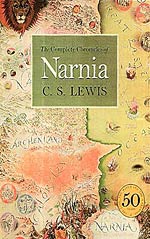
![]() jynnantonnyx
jynnantonnyx
1/2/2013
![]()
It all began with a wardrobe. Being your average, American, suburban child, of course I had no idea what a wardrobe was. All I knew was that it was far larger on the inside than the outside, large enough to house a fairy kingdom of gods and talking beasts, of hidden kings and snowed in lampposts.
The stories of C.S. Lewis’s Narnia series are in a certain sense pretty standard fare: a child living in unappealing and banal circumstances finds a doorway to a magical realm, has many adventures in said realm, then returns to find that life in the normal world is much enriched by the experience. It would be hard to find a more prototypical plot than this. Even so, Lewis’s series manages to stand out in a crowd of similar stories, and I suspect this is because he evoked a world that is lost, but which was very much real: the Middle Ages.
Being a scholar of Medieval literature by trade, Lewis was well-suited to the task of reviving a dead age. His book The Discarded Image is an introductory exploration of the way Medieval man viewed the world, which was as a subtly complex and interconnected system that hummed in a sort of clockwork harmony. It was a world rife with symbols and archetypes, with God at its source, and all his creatures working either against or with this source.
So of course modern fantasy writers hate it. Neil Gaiman and Philip Pullman are the most recent detractors, vilifying Lewis’s books as being nothing more than religious propaganda. They are not entirely wrong. Lewis was hardly ashamed of his conversion to Anglicanism, publishing many books and essays on both his conversion and the theology of his new religion. When it came to writing fiction, Anglican-Protestant theology was a motivating force, as well. His Cosmic Trilogy is clearly theological in places, especially in Perelandra, which served as a “scientifiction” reimagining of Paradise Lost on another planet. The Narnia series is even more blatantly Christian in as much as it depicts Aslan, a talking lion who is not simply a Christ-figure or an allegory, but Christ himself.
So of course Tolkien hated it. Lewis’s Catholic friend and fellow writer could only accept Lewis’s books as allegorical works because of the theological problems that would arise with a literal intention. Lewis himself published an introductory study to Medieval allegory, The Allegory of Love, and he knew his own intentions well enough to know that he was not writing an allegory. The structure of the series, and many of the characters therein, are densely symbolic (cf. Planet Narnia by Michael Ward), as is Aslan’s leonine appearance, but the character himself is controversially straightforward.
Oddly enough, none of these controversies have diminished the series’ popularity. Children and young adults everywhere continue to read them, finding inside something too often lacking in today’s literature for young people: a sense of wonder. From Mr. Tumnus’s cozy home to the Green Lady’s cavern, from the deserts of Calormen to the edge of Aslan’s country, Narnia is an unceasing flow of delightful places and events. The popularity of the recent Narnia films proves that the series has legs in the modern world. Lewis would probably be the first to insist that one should read for delight rather than duty, and even his popular detractors can’t make the books unpleasurable to read, except for unhappy adults who insist on writing and reading propaganda of the opposing sort. I think we can expect Narnia to stick around for a long time.
http://blog.worldswithoutend.com/2011/11/ya-genre-fiction-month-the-chronicles-of-narnia/